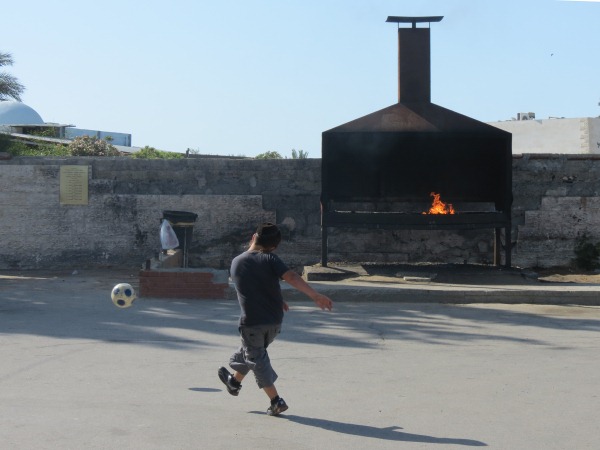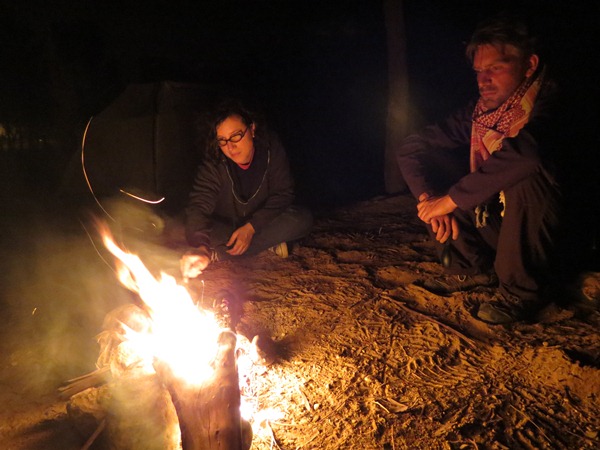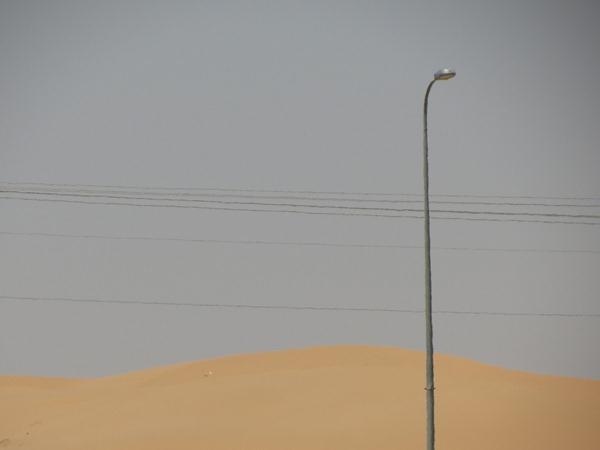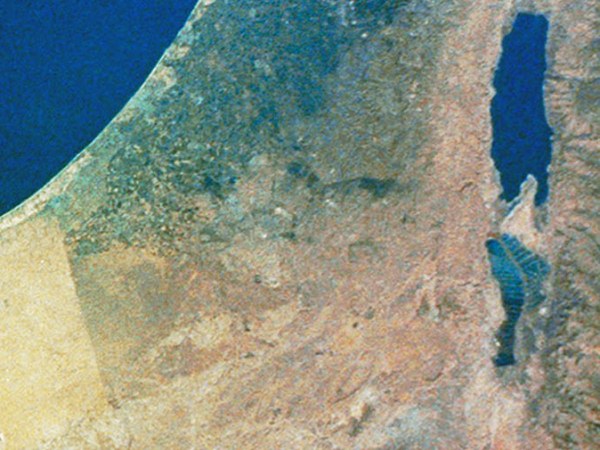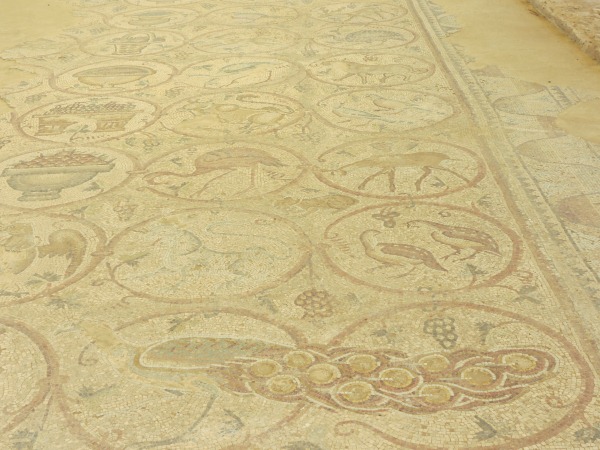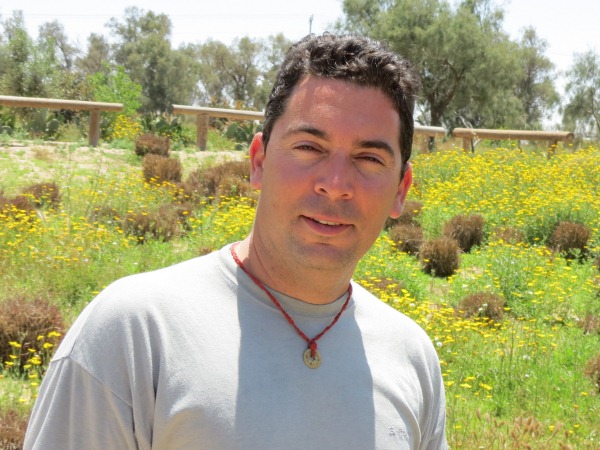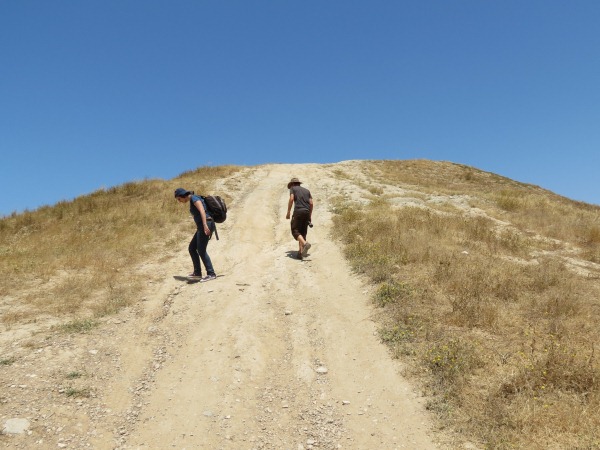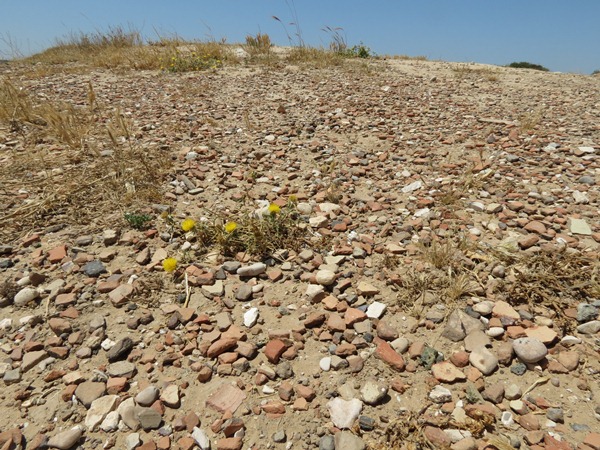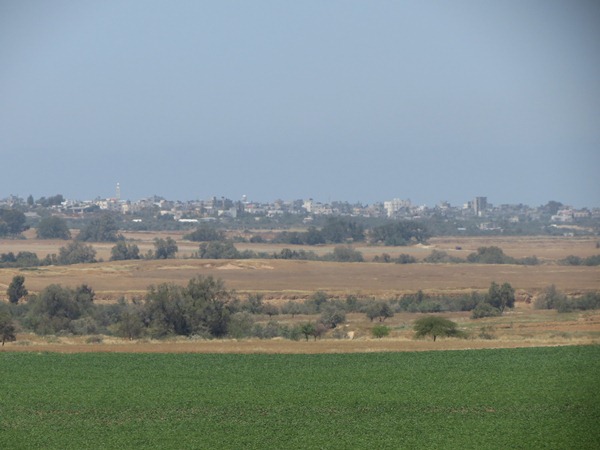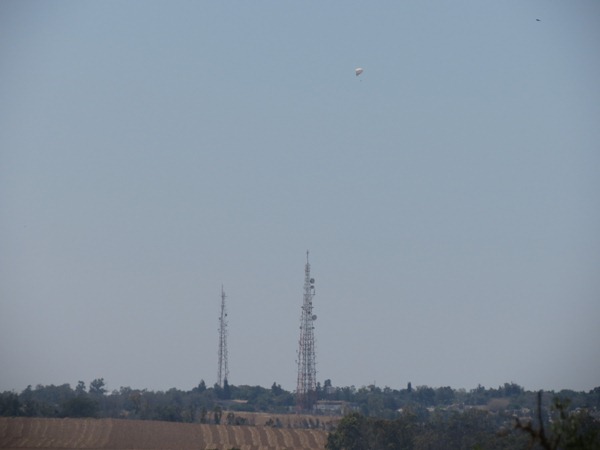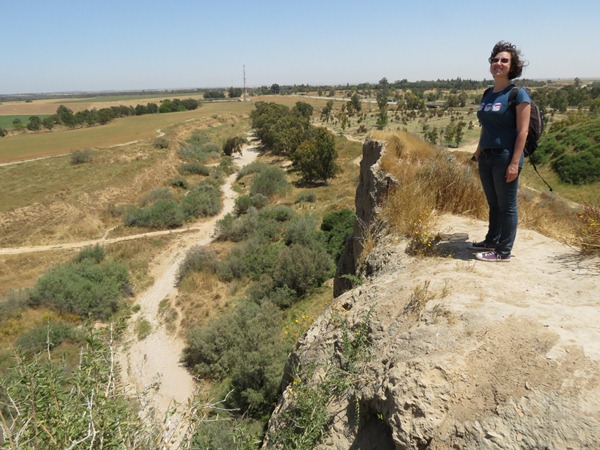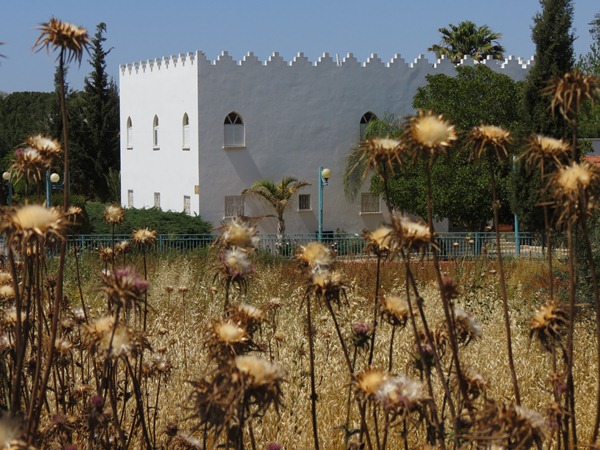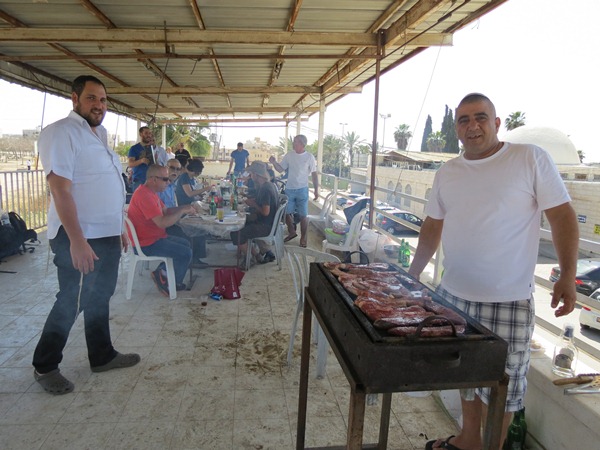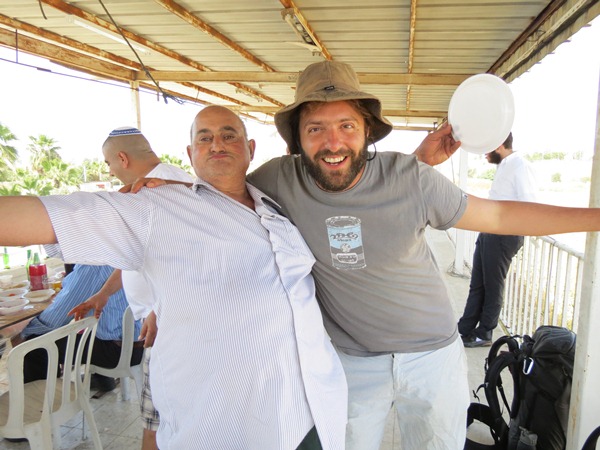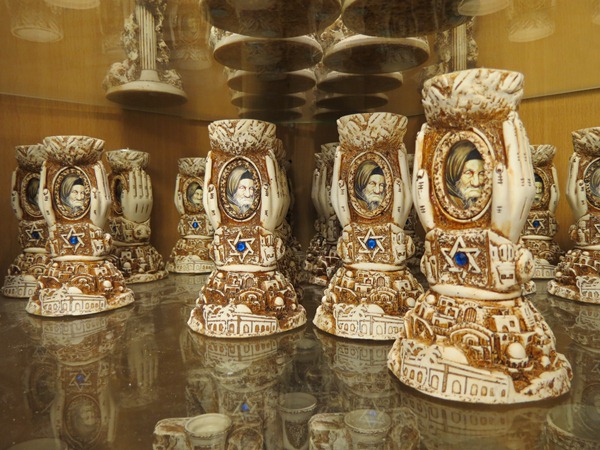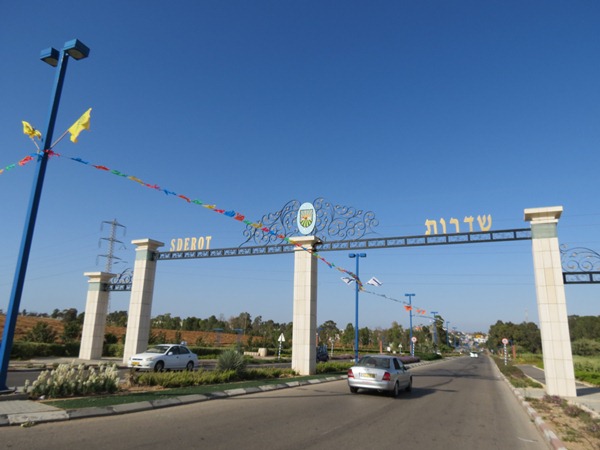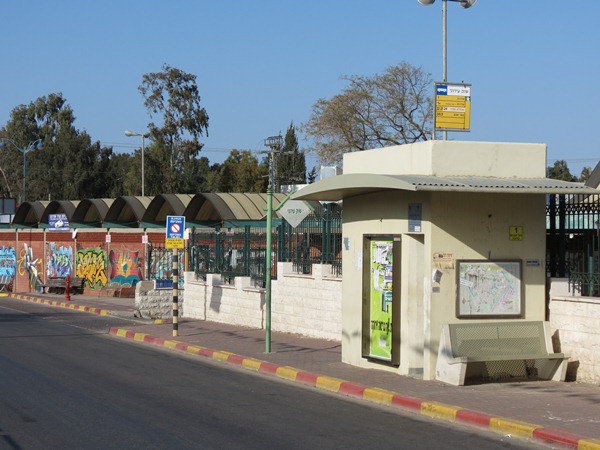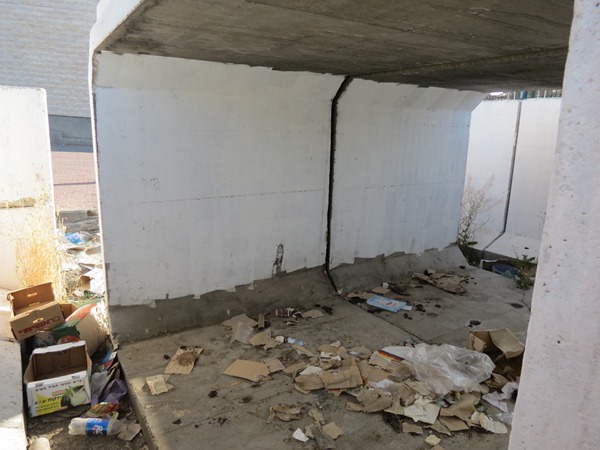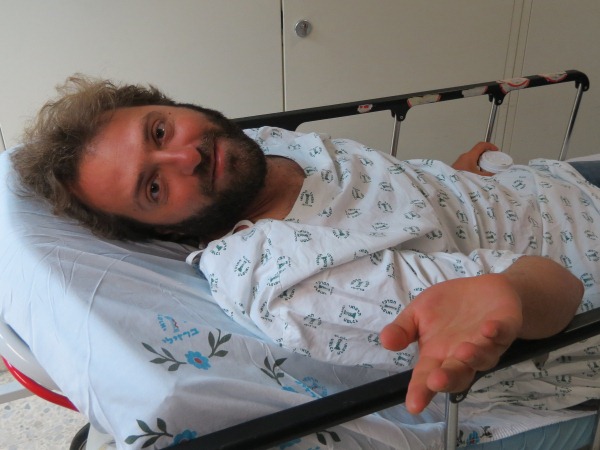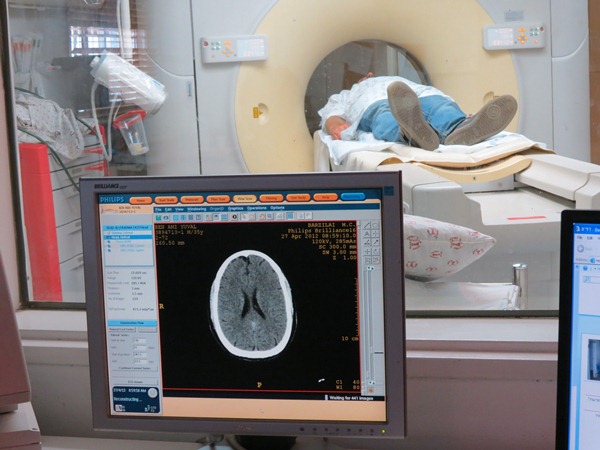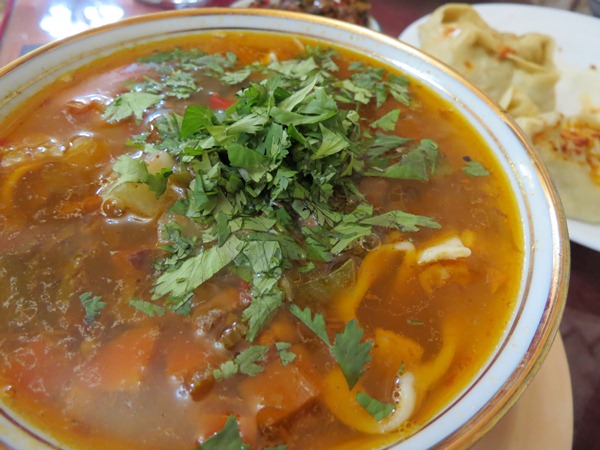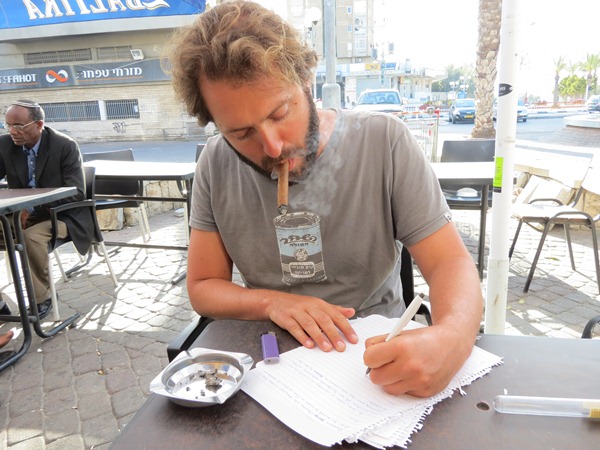From Nir Oz to Askelon via Agadir, the land of broken pots and the city of dirty bunkers
Ewan and I build a fire outside Kmehin, both to warm ourselves and to impress a very special newcomer. Ruthie is here. She took the train to Beer Sheva, then caught a bus to the border and made it on time to enjoy the fireworks.
After both fireworks and fire die down, the big sphere of flames rises again over the desert and allows us to take a good look at our whereabouts. We are in one rare corner of the Negev that is sandy, and Kmehin is prettily nestled in pink dunes.
West of here, across the border, the terrain is sandier still, so sandy that the man-made, straight line distinguishing Israel from Egypt can be seen from space, as seen here on the lower left-hand side (image: Wikimedia Commons/TheCuriousGnome).
Close to the coast, it is agricultural land in Israel and dense urbanity in the Gaza Strip that contrast with the sparsely populated Sinai, but further south, desert meets desert and the border should have been invisible. The effect is caused here by goats and tanks. In the Sinai, livestock eats most of the vegetation, while in Israel, where the land is used as firing ranges by the IDF, Bedouins are banned from grazing their herds in the expanses. Thus, the Israeli dunes remain dotted with low brush, which dyes them a darker brown.
The driver who takes the three of us through the sagebrush would love to see the dunes used differently. “They could have had a wonderful nature reserve here,” he says, “It could be a joy to all, if only we changed our perspective a little bit. This area is completely contaminated with military. You need to live here in order to really see that, we can’t move freely in any direction: here there’s a fence, there a firing range…”
His name is Yinon and he lives in Kibbutz Kissufim, where he also grew up. Kissufim is located very close to the fence with which Israel surrounded the Gaza Strip. Yinon is thus one of the Israelis most threatened by Hamas bombings, but he feels that the widespread concern for his safety is unjustified. “They blow it out of proportion,” he says, “This is a beautiful, magical region, but Israel keeps it in political complications. So yeah, every so often we get fireworks, it’s not a big deal.”
Israel blames Hamas for ceaseless aggression, to which it responds with aggression of its own. Yinon is suspicious of this cause and effect axiom. “The IDF has such sensitive equipment around here that it can detect a rabbit crossing a field at night. I know this for a fact. They are in the know about everything that’s happening inside the Strip, but they let the occasional missile fly, so they can then run weeping to the Americans to get more money.”
“People who live here know this,” he adds, “We see the trucks that go into the Strip. Some of them carry pipes, the same pipes that are used to make Qassam rockets. “So Israel won’t let building materials in, claiming that they can be used for bomb construction, but it does let in those pipes. Does that make sense? Yes, awkward sense. Keep the south traumatized and weak, keep the cameras on the smoke coming from our fields, and you can easily fend off any criticism.
Yinon came back to the region after living a few years in Spain, where he practiced osteopathy. “You go out to the world and you see things differently,” he says. “The Palestinian guy who lives behind the fence is not focused on killing me all the time. He needs work and he needs peace and normalcy. If we started working on actually bettering this region, we could all benefit from what it has to offer. This is the Holy Land, we could get millions of tourists here and prosper together. I can’t see why this isn’t happening.”
“Some industries may be more powerful than the tourism industry,” I suggest.
We pass by Kibbutz Nir Oz, where Yinon drives out of his way especially to show us the remains of an ancient synagogue. Roadworks near the kibbutz expose a beautiful mosaic floor, which dates back to the 5th century AD and features both a menorah and a peacock.
Around us, the desert is already giving way to green fields separated by rows of cypresses and eucalyptus, and even to beds of wildflowers. I take a photo of this special man, who breaks many a stereotype, against our new surroundings.
Ewan enjoys the mosaic floor, but I know that he will go crazy over the place where Yinon drops us off. Right over the intersection rises one of this country’s many “tellim”: man-made hills that once helped fortify small ancient settlements and later became the acropolises of larger towns. As soon as we begin climbing it, Ruthie makes a discovery,
She needn’t strain her eyes, though, because most pebbles on the top of the hill are in fact pieces of shattered pots. Tel-Jamma was first settled nearly 6,000 years ago, and abandoned in the 2nd century BC. I can only assume that it was the center of a bottling industry, to which desert nomads delivered ointments and spices, soon to be shipped abroad. If Wadi Bsor, which snakes at the foot of the hill, once served as a river flowing year-round, this may have even been a port.
From the hill we get a good view of the broken pot of a country in which we live. To the west, across a well-guarded fence, is the village of Mughazi in the Gaza Strip.
Above us, high over the tips of enormous antennas, a balloon lifts sensitive cameras to monitor the Gaza Strip 24 hours a day. Say cheese, Gazans.
We are in such a strange place, a quiet, fertile countryside, sandwiched between empty desert sands and the world’s most densely populated geopolitical entity. A walking distance from here, the 1.7 million people of the Gaza Strip live under fundamentalist Hamas rule and are confined by Israel to an extremely narrow territory. We can only hope that they somehow manage to enjoy this lovely spring day as much as we do.
The Strip itself is closed before us, and the fence is as decisive as that separating Israel from Lebanon, a sovereign country. So we give up on Gaza and continue north.
Surprisngly, even three travelers get lifts very easily in the Israeli countryside. The next one takes us to the town of Netivot, which to the naked eye looks like any Israeli “development town,” but is in fact a special place, a holy place.
Jewish immigrants from Morocco were more or less tossed here in the 50s by the Ashkenazi hegemony. This way, they were kept out of the cities, and also populated the frontier next to what was then the Egyptian border and the city full of refugees across it.
Soon a spiritual leader known as the Baba Sali came from Morocco to dwell in Netivot, and the town became known for the cult of adoration centered around him. We thought of keeping the holy man’s mausoleum for last and grabbing something to eat first, but all restaurants are shut for Independence Day. Only the DVD library is open and its owner tells us to head to the Baba Sali’s gravesite. “You’ll get a lot to eat there, for free,” they promise.
So we head down towards unusual white buildings on the towns outskirts. Ewan, who traveled in Morocco, recognizes elements of Agadir’s architecture.
The entire area smells strongly of roasted meat, and soon we get to taste some. A family is celebrating the holiday with a barbecue on a wide, paved patio overlooking the grave-site and the installation for burning candles, seen in this post’s opening photo. A hearty, full-bodied gentleman named Yehuda invites us to the table within two seconds of noticing us, on the condition that Ewan and I cover our heads and show the holy site respect. “The man who is buried here is one of the pillars of this world.” explains Yehuda. “Have some grilled sheep liver.”
The parking lot below is full of other families and more smoke. Soon we learn that the patio is the mausoleum’s pulpit, and is reserved for aristocracy. Feasting with us today is the Baba Sali’s own great-gandson, Abba Abuhatzeira. Here he is on the left.
The Baba Sali himself was vegetarian, so devouring so much meat next to his final resting place seems like an assault on his legacy, but our hosts certainly take him and the old country seriously. They preserve so much of Morocco, from the hospitality to the Arabic they speak among them, to the songs of Sami Al-Maghribi playing on the boombox, that Ewan is baffled. I explain to him that while the Zionist ethos does not permit the concept of “Arab Jews,” it would be difficult to define these people otherwise. They are Arab and Jewish and Moroccan and Israeli and they are wonderful.
The sheep liver is soon followed by delicious grilled chicken breasts, then by lamb ribs, then by proper steaks. Yehuda pours us wine, then beer, then Black Label Johnny Walker. Ruthie is sitting at the very edge of a table reserved for women, just close enough to the men’s table to join our conversation with a man David.
David was born in Morocco and moved to Israel at the age of 14. He fought in the war of ’67 and helped conquer the Golan Heights. Later in life, he entered the fruit and vegetable trade and did much of his business in Gaza.
Once more I am amazed. Here is another Israeli, one with very different background than that of Yinon, who also spends much of his time in bomb shelters, and yet expresses neither fear nor antagonism when speaking of his neighbors to the west. “We respected them and they respected us. That’s how it always was. I still believe that every person on this earth deserves respect, be they Jewish, Christian or Muslim.”
I’m glad to pack these words with me when the time comes to leave. We bid farewell to everybody and descend briefly to visit the mausoleum itself, use the bathrooms and take a photo of the candlesticks in the gift shop. Adorned with a likeness of Jerusalem and a portrait of the Baba Sali, and designed to resemble the hands of a mother blessing shabbat candles, they simply have to be my favorite objects in the entire country.
David volunteers to drive us just out of town, where we may board a sherut minivan headed for the next town, Sderot. Thanks to all the whisky, wine and beer in my head, I miscalculate the dimensions of the sherut’s doorway, and while trying to lift myself and the heavy backpack through it, headbutt its steel frame with all my might. I don’t pass out, but remain in serious misery all the way to Sderot.
Ewan continues north to Tel Aviv. He had a good time, but two days are about as much as one should spend in a country’s least visited and most desolate regions, before heading for its “must sees.” Ruthie and I disembark at Sderot’s gates, then advance on foot into the town. We are forced to stop frequently, since I am nauseous and weak.
While Hamas missiles easily reach as far as Be’er Sheva, Sderot is the town most recognized as the Israeli target. Even its bus stops are fortified.
I have been here in times of heavy bombardments, and sang to the poor kids stuck in the bomb shelters. I knew then as I do now that Sderot’s plight is miniscule compared to that of nearby Gaza. In half a decade, 13 Israelis died of rocket attacks in this area, compared to 1,417 Gazans killed by the IDF in less than one month, during “Operation Cast Lead.” When researching this detail, I notice that that Gazan casualties are not mentioned in the Hebrew Wikipedia page describing those events. Under “casualties” appears the number three, referring to three Israeli soldiers who were killed by friendly fire.
If we only look at ourselves, as we are taught to, then our situation does appear terrible. However, all we need to do is look at ourselves closely, and we soon we find that we are being exploited. Here is what the inside of a bomb shelter at Sderot looks like:
It is full of human feces and trash, as are all of the ones I enter. (This one was the cleanest. Others were unphotographable.) This is not how people treat facilities that they feel truly protect their lives. I tend to side with Yinon. Sderot is more of a propaganda tool than a disaster zone. It is far more the victim of Israeli policies than of Hamas.
Is the Netanyahu-supporting God of Israel punishing me for such views? I am not well. The headbutt. It did something bad to my head. Ruthie and I continue to the coastal city of Ashkelon and get a very basic hotel for the night. Its what we can afford, but maybe we should have splurged. The soap in the bathroom is unwrapped and there’s a dirty towel in one of the drawers. The teen-aged Russian receptionist is playing cards with a friend on the lobby couch, next to an electric organ on which no one has played since the 80s or so.
I wake up in severe pain, my skull is exploding. Ruthie takes me to the hospital in a cab, where the doctors fear the blow caused me cerebral bleeding and rush me to do a head scan.
Here is my brain on Ashkelon. In fact, here is my brain also on Virginia. The entire wing of the hospital in which I lay was donated by the right-leaning IFCJ (International Fellowship of Christians and Jews). This organization uses the same fiery “Israel is under constant attack” talk to fund-raise among evangelical Americans, then supports regions such as this, where the government invests only minimally.
They say that most accidents happen at home. They’re right, and still it amazes me that after climbing a fence to escape the closed military zone on the Lebanese border, leaving Jenin under a loaded gun and being held in the basement by the secret police in Egypt, it is a stupid sherut minibus that actually causes me physical damage.
Anyway, it isn’t such great damage, and the scan shows no bleeding. I am only suffering from a concussion that is intensified whenever I lay down. The doctor perscribes pain killers and warns me not to look at television screens or a computer monitor for the next day. Cute Ruthie, whom the angels chose to send to me one day before I needed loving company, treats me to a healthy Central Asian “lagman” soup, made by Uzbeki Jews in Ashkelon’s old center (which before 1948 constituted the town of Majdal),
and buys me a cigar as a treat. I write a new post by hand, as the ancients of Tel-Jamma wrote in their day, as the Baba Sali wrote when he was still alive, as everyone around here will someday write, using a quail feather and ink made of cooked snails, if we keep letting the bastards run the show.
_______________________________________
The Round Trip thus far!
View Larger Map
Thanks for reading and taking part in the adventure. All writing on this site is done voluntarily, so if any of you would like to pitch in directly for my travel expenses, please click here or on the “donate” button at the top of this page to do so. Donors who contribute more than $25 will receive free the first part of the three-part ebook (compatible with iPad) that will be released this summer. I’m deeply grateful to those who already donated. Thank you so much! This project would be impossible if not for you.
Relive the first two journeys:
The September Journey
The Christmas Journey


